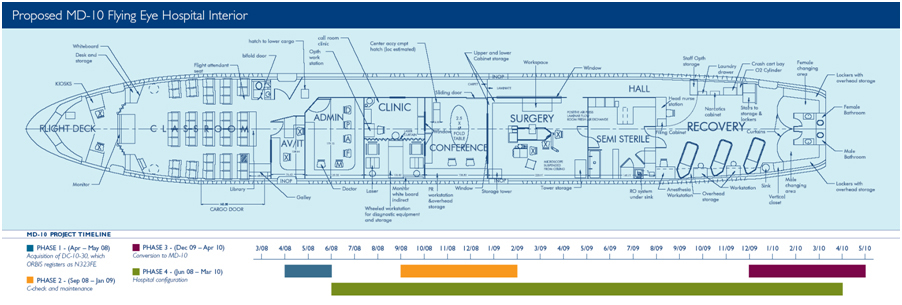Flying Eye Hospital Prevents Blindness Worldwide
By on Jan 3rd 2018
In the late 1960s, ophthalmologist Dr. David Patan returned to the United States after spending time abroad with a startling truth: 217 million people are visually impaired and 80% of these impairments are avoidable.
Dr. Patan worked to make eye care accessible to everyone through mobile stations and educate as many people as possible on the topic. The concept of Orbis came from Patan’s international experiences, and by 1970 was established as a freestanding non-profit in New York City.
Patan then recruited a group of doctors, aviators, and philanthropists and set out on a mission to bring quality eye care to people with vision problems around the world. He named it Project Orbis International and the Flying Eye Hospital was born.
First Flight
Project Orbis had its official start in 1982 when the foundation’s first Flying Eye Hospital took flight. The DC-8 visited 24 countries and educated several doctors through hands-on surgical training.
Hundreds of leading ophthalmologists from various countries volunteered to practice in the hospital and over 40 countries hosted the plane by 1987.
However, the DC-8 became more difficult to maintain as time went on because of expensive parts and a lack of space for equipment. Private donations allowed Orbis to purchase its second plane in 1992, a DC-10. Its interior was twice as large as the DC-8 and entered service in 1994 with its first flight to Beijing, China.
FedEx donated a larger, DC-10 Series 30 freight airplane in 2010 and it was converted to the current Flying Eye Hospital in 2016. It can fly twice as far as the DC-10, holds the most up-to-date medical ophthalmic equipment, and offers the same services as ophthalmology centers on land.
Over the past five years, the charity has trained over 10,000 doctors, performed more than 12.5 million eye exams, and conducted 350,000 eye surgeries.
A Hospital with Wings
 MD-10 Flying Eye Hospital Interior Blueprint.
MD-10 Flying Eye Hospital Interior Blueprint.
Patients are taken by ambulance to the Flying Eye Hospital, which is stationed on the tarmac for procedures.
The aircraft has nine different areas making the hospital fully functional. An admin office occupied by the plane’s maintenance team sits in what once was the cargo hold. The audio/visual room provides onboard Wi-Fi, as well as monitors cameras inside the plane.
Surgeries can be broadcast to students in the classroom at the front of the plane and around the world. The back of the plane houses the operating room filled with 3-D monitors, scalpels, and microscopes, and there is also a recovery room for post-op patients nearby.
One of the most unique and important qualities of the Flying Eye Hospital is that it’s self-sustaining. The hospital produces its own oxygen, powers equipment with its own fuel, and has a bacteria-killing water filter.
Sources:
http://www.orbis.org/en/news/2017/cnn-steps-on-boa...
http://www.orbis.org/en
http://www.owsp.org/international-participants/dav...
https://www.cnbc.com/2017/11/27/take-a-look-inside...
https://www.thebalance.com/orbis-the-flying-eye-ho...







